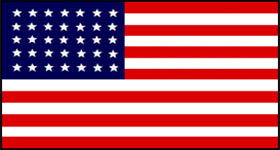Civil War Battles |
Colonial Wars |
American Wars |
Link To This Page — Contact Us —
The Battle of Adobe Walls
November 25, 1864 in Hutchinson County, Texas
Southern Plains Campaign
Union Forces Commanded by:
Col. Christopher (Kit) Carson
Indian Forces Commanded by: Chief To-hausen (Dohäsan)
*Killed and Wounded/ m=missing Conclusion: Union Victory |
 |
BATTLE SUMMARY
The Battles of Adobe Walls got its names from a trading post established on the north side of the Canadian River in 1840 by Bent, St. Vrain & Company to attract the trade of the Kiowas and Comanches. Unable to make a profit, William Bent and his partner abandoned Adobe Walls by 1843. In 1848, it was blown up by the traders after repeated Indian
attacks.
Brig. Gen. James H. Carleton, commander of the Department of New Mexico, determined to punish hostile Plains tribes. The Comanche and Kiowa Indians of the Southern Plains had attacked several Santa Fe wagon trains on their way to the Arizona and New Mexico territories. Determined to put a stop to these attacks, Carleton sent an expeditionary force led by Col. Christopher (Kit) Carson to locate the tribes in their winter campgrounds. Carson was familiar with the Adobe Walls area. He was a buffalo hunter in the area in the mid-1840's.
Carson had commanded earlier expeditions against the Navajo. Carson, who commanded the 1st New Mexico Volunteer Cavalry, set out for the Kiowa and Comanche camps along the Canadian River in the Texas panhandle from Fort Bascom at Cimarron, New Mexico. He had 396 soldiers, including 72 additional Utes and Jicarilla Apaches. The Indian forces were led by the Kiowa chief Dohäsan
At 8:30 A.M., Carson attacked Dohäsan's camp and routed the Indians. Bt 10:00 A.M., Carson was in the ruins of Adobe Walls. The Comanche village was located beyond the ruins. The startled Indians ran away, regrouped near the abandoned trading post. Combined with the Comanche tribe, Dohäsan led a counter-attack.
The tide was turned and, grasping the gravity of the situation, Carson and his men were forced to retreat to where their mountain howitzer platoon were located.
He sought shelter in the ruins of Adobe Walls. They had escaped certain death from the Indians by retreating, thanks to the action of the howitzers, commanded by Lt. ?? Pettis. Pettis unlimbered two 12-lb. howitzers, strategically placed on a rise behind the village, and Carson ordered them to fire on the Indians.
The Indians led several sporadic charges but the Federals were able to hold their line. Dohäsan tried lighting the grasslands on fire to use as a smokescreen. Carson was running low on ammunition and was concerned with protecting his supplies. He lit his own fires and withdrew to the high ground around the howitzers, where he repulsed the last of the Indian attacks. He ordered the Kiowa lodges and winter supplies burned. The Kiowa-Apache chief, Iron Shirt, was killed when he refused to leave his tipi.
The Battle of Adobe Walls was one of the largest battles ever to
take place on the Great Plains between Union soldiers and the Great Plains Indians. The results of the battle was a tactical draw but Carson claimed it as a victory because he was able to burn the Kiowa camp and winter supplies.. Carson was acclaimed as a hero for successfully striking a blow against the Indians and for leading his men out of the trap with minimal casualties. The battle succeeded in reducing the frequency of Indian raids along the Santa Fe Trail.
Carson was able to make their retreat during the night of November 26 and early morning of November 27.
When Carson returned to Fort Bascom, Carleton praised his ability against a far superior foe.
